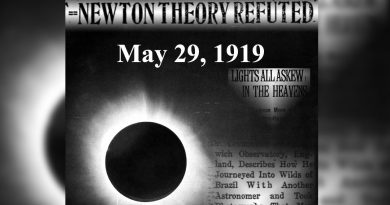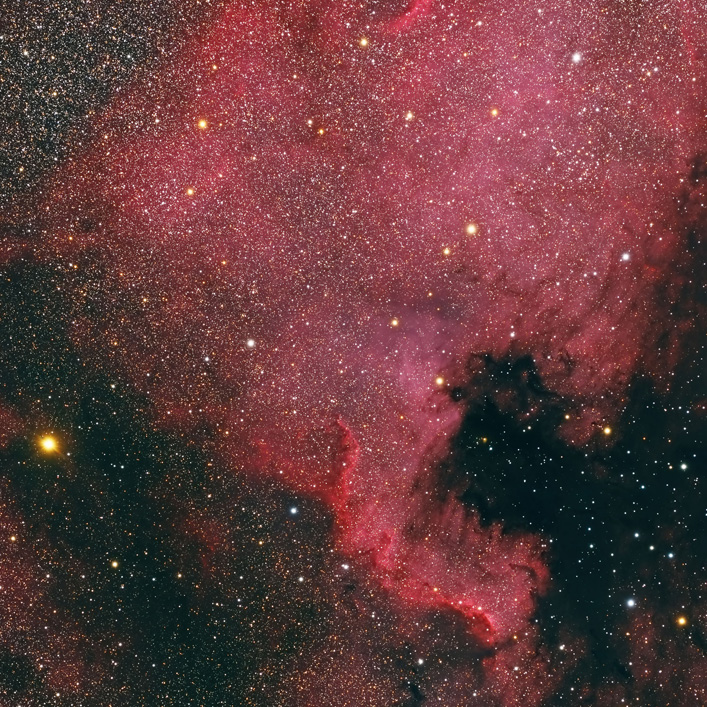Each Tele Vue Telescope Explained in ONE Image
No single telescope is best for every application, that’s why our all-APO refractor lineup has a range of scopes of various sizes. All are visual and imaging capable to suit your whims. In this blog we’ll take a tour of Tele Vue’s refractor offerings through sample images made by each model.
Tele Vue-60
Our smallest APO scope (OTA length only 10″) is also one of our most versatile: great for astronomy and birding on-the-go. The image below, made in Hydrogen-α light, allows us to see solar prominences dancing around the limb of the Sun. Some have become detached from the Sun (at the 10 and 1 o’clock position) as coronal mass ejections. The large dark grouping of spots near the bottom is Active Region 3435. Like all the other dark spots on the solar surface, these are caused by magnetic fields that make that area of the Sun appear dimmer. The dark filament near that region is a prominence that appears dark against the surface of the Sun. Shorter filaments are scattered around the surface. The light colored regions, often associated with active regions, are called plages. The mottled pattern on the surface of the Sun are caused by fibrils: magnetically-confined super-heated plasma jets reaching 2,000 to 6,000 miles (3,000-10,000 km) high.

Tele Vue-76
Our next-most portable APO really excels in wide-field, deep-sky, imaging: the 2″ drawtube and short focal length combine for a gigantic 5.5° field. Want more? Our 0.8x TRF-2008 Reducer/Flattener (fully multi-coated 3-element) converts the native 480mm, f/6.3 Tele Vue-76 to a 380mm, f/5.0, flat field, super-wide (6.7°), imager. The flat, wide field of the Tele Vue-76 with reducer/corrector is perfect for framing the large star-forming regions in Scorpius and Ophiuchus in the image below. Composed of glowing ionized, dark, and reflection nebulae, it is a study of color and contrasts. The brightest star on the top of the left side is Omicron (ο) Scorpii. Sliding down that side of the image is the blue nebula IC 4603 in Ophiuchus, a reflection nebula that scatters blue light from the central star and is part of the Rho (ρ) Ophiuchi cloud complex. That dark nebula tagging the lower-left of IC 4603 and leaving the frame, like a sideways smile, is LDN 1686. The dark cloud between IC 4603 and ο Scorpii is known as Dobash 7196. The bright star embedded in the red and blue glow at the center of the image is Sigma (σ) Scorpii (Al Niyat). Toward the lower right is the spectacular globular cluster M4 (NGC-6121) in Scorpius. The nebulosity at the bottom of the frame is mass loss from the off-frame, red-supergiant star Alpha (α) Scorpii, known as Antares “the heart of the scorpion”.

Tele Vue-85
Like the prior two telescopes, our f/7 Tele Vue-85 is small enough to be an airline carry-on, spotter/birder scope and big enough to be your astronomy telescope. The 600mm focal length produces a 4.4° imaging field which can be stretched to 5.5° at f/5.6 with the 0.8x TRF-2008 Reducer/Flattener. Feast you eyes on the image below: glorious wisps and folds of glowing Hydrogen gas surrounding the Horsehead nebula (Barnard 33) revealed with the Tele Vue-85 in a long hyper-exposure. The silhouette of a Horse’s head at image center is formed from ionized gas glowing behind a dark concentration of dust. The predominantly hydrogen gas behind the nebula is ionized by a nearby star. A short distance to the left of the “head” lies the Flame Nebula (NGC 2024). The flame-like appearance is created by dark “rifts” of light-absorbing gas lit up by the eastern-most star in Orion’s “belt”, Alnitak, above it in the image. The glowing ball trailing the “Flame” to the left is IC 432, a reflection nebula.

Tele Vue-NP101is
This 101mm, f/5.4 (4-element Nagler-Petzval) APO Refractor is an imaging/visual tour de force. With DNA inherited from the venerable Tele Vue-NP101 refractor, the Imaging System (“is”) version features a 2.4″ diameter drawtube and larger rear lenses to illuminate a 50mm image circle with 5.3° field. We build and test every focuser with 12lbs. of weight to withstand sag, the drawtube features tilt compensation, and 10:1 dual-speed pinion assembly ensures precise focus control. It’s without compromise for visual use as well. The great field of the Tele Vue-NP101is was put to good use recently for imaging bright comet C/2023 P1 Nishimura and it’s impressively long ion tail. With its projected 406 year orbit, this icy, dust-ball will not soon again grace the skies of Earth. However, parts of it may: the cometary orbit matches that of the Sigma Hydrids (constellation Hydra) meteor shower that is active from late November to early January. According to the Central Bureau for Astronomical Telegrams, Telegram No. 5290, “Observations are encouraged from the end of November to early December” this year.

Tele Vue-NP127is
The Tele Vue-NP127is (127mm, f/5.2, 4-element Nagler-Petzval APO refractor) is the Tele Vue-NP101is’ big brother with 58% more lens area and faster speed. It has the same features as its little brother with a 4.3° field across the 50mm image circle. This is perfect for framing many extended objects in the sky. The featured object below is listed in Lynds Catalog of Dark Nebulae (LDN)

Tele Vue-NP127fli
This 127mm, f/5.3 (Nagler-Petzval with Large Field Corrector) APO Astrograph Refractor is a special version of the Tele Vue-NP127is designed to work with the Finger Lakes Instrumentation Atlas focuser and its “zero-tilt” adapter. This 5-element system produces a 4.3° field across the 53mm image circle. The image below, made with this telescope, contains objects in the constellation Sagittarius. At top are the blue and red pedals of the Trifid Nebula (M20 / NGC-6514). A giant star in the center of the structure ionizes a cloud of hydrogen gas to glow red, while dark nebulae cut paths through the nebulosity. This same light reflecting off a dust cloud appears blue — due to preferential scattering of the dust. The large red object toward the bottom is the Lagoon Nebula (M8 / NGC-6523) — a giant star forming region with an open cluster of stars (NGC 6530) embedded within. Giant O-type stars in the cluster pump out massive amounts of ultraviolet light that energizes the gasses in the nebula and cause them to emit light. To the left of the Lagoon, toward the edge of the field, is the NGC-6559 star-forming region: clouds of dust and gas are condensing to form new stars here. Energetic photons from the new stars collide with the hydrogen gas in the nebula to cause the red glow. The blue color, seen in close-up views along some edges, is this light reflected from clouds of dust from exploded stars. Dark nebulae, composed of material too dense for light to penetrate, meander their way through these colorful clouds of stardust.

Did you observe, sketch, or image with Tele Vue gear? We’ll like your social media post on that if you tag it #televue and the gear used. Example:
#televue #tv85 #trf2008 #horsehead
Do you want your Tele Vue images re-posted on Tele Vue Optics’ Social Media accounts? Use this hashtag for consideration:
#RPTVO
More Info
- Tele Vue APO Design and Build “Secrets” spills the beans on our telescope design and build philosophy.
- For DSO imagers, our Pixel Peeping blog will help you on the path to great images.
- TV-60 page on our website (mobile version)
- TV-76 page on our website (mobile version)
- TV-85 page on our website (mobile version)
- TV-NP101is page on our website (mobile version)
- TV-NP127is page on our website (mobile version)
- TV-NP127fli page on our website (mobile version)
- Tele Vue Telescope Recommendations and Specs (PDF)
- All Tele Vue telescopes come with a 5-year Limited Warranty






